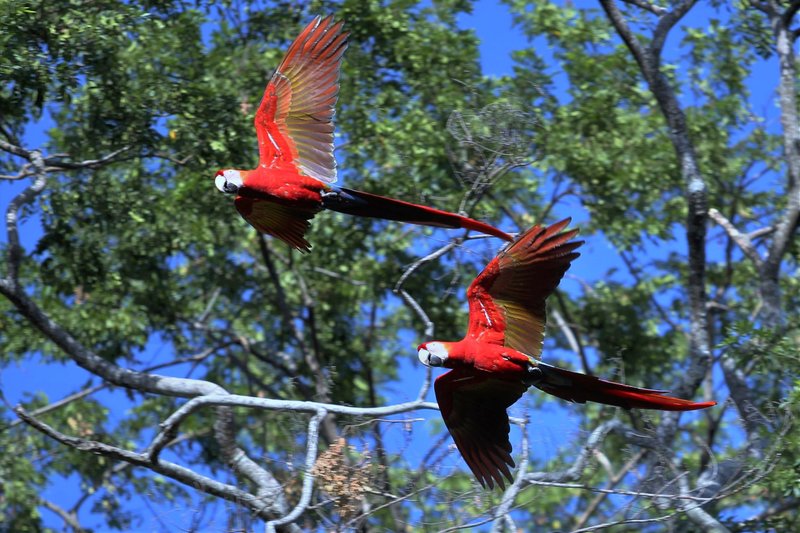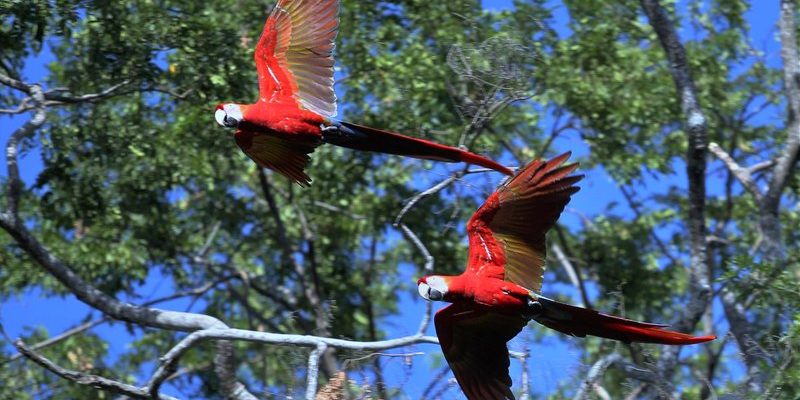
But here’s the thing: scarlet macaws are facing serious threats. Habitat loss, poaching, and climate change are taking a toll on their populations. Luckily, many organizations and passionate individuals are working tirelessly to protect these incredible birds. Understanding these conservation efforts can help us appreciate not only the contributions we can make but also the significance of keeping the scarlet macaw and its habitat safe.
Understanding the Scarlet Macaw
Before diving into conservation efforts, let’s get to know the scarlet macaw a little better. These birds are primarily found in the rainforests of Central and South America, living in regions like the Amazon Basin and parts of Mexico. They thrive in tropical climates, where tall trees provide the perfect environment for nesting and foraging.
Scarlet macaws are highly social creatures, often seen flying in pairs or small family groups. With a wingspan nearing three feet, they’re not only striking to look at but also incredibly adept at maneuvering through dense forest canopies. These birds feed mainly on fruits, nuts, and seeds, playing a key role in their ecosystem by dispersing seeds throughout their habitat. When these birds are around, the rainforest flourishes.
You might be wondering why these beautiful creatures matter. Well, their presence indicates a healthy environment. When scarlet macaws thrive, it often means other species are doing well too. Their decline is a warning sign that something might be off in the ecosystem. Protecting them is essential not only for their sake but for the overall health of the forests they inhabit.
The Threats Facing Scarlet Macaws
Scarlet macaws are facing a grim reality. Their biggest threat comes from deforestation—as humans clear land for agriculture and urban development, these birds lose their natural habitats. Imagine being told you have to leave your home and finding nowhere else to go. That’s what these birds experience when their trees are cut down.
Another significant threat is illegal trapping and poaching. Some people capture these birds for the pet trade, lured by their beauty. While having a scarlet macaw as a pet might sound appealing, it comes at a huge cost to their communities in the wild, breaking family bonds and altering their natural behaviors.
Lastly, climate change affects scarlet macaws by altering their habitats. Changes in temperature and weather patterns can impact the availability of food sources, creating challenges for these birds to survive. Additionally, increasingly frequent and severe storms can destroy their nesting sites.
Conservation Organizations and Their Impact
Many organizations are stepping up to protect the scarlet macaw and its habitat. One of the leaders in this space is the World Wildlife Fund (WWF), which works globally to conserve biodiversity. They focus on protecting the forests where scarlet macaws live, ensuring these vibrant birds have a future.
Another significant player is BirdLife International, which monitors bird populations and advocates for their preservation. They implement programs directly in the field, collaborating with local communities to promote sustainable practices that benefit both people and wildlife.
Additionally, many local organizations are devoted to rehabilitation projects for injured or orphaned scarlet macaws. These efforts not only help individual birds but also raise awareness about the threats they face.
By supporting these organizations, we can help ensure that conservation efforts continue to thrive, ultimately giving these birds a fighting chance.
Community Involvement in Conservation
While large organizations often grab the headlines, local communities play a crucial role in conservation efforts for the scarlet macaw. Engaging local people is essential because they are the guardians of these forests. They know the land better than anyone and can tell when something is amiss.
Community-based initiatives often involve eco-tourism, which allows locals to earn a living while protecting their environment. By bringing visitors to see scarlet macaws in their natural habitat, communities can showcase the beauty of these birds, creating a financial incentive to preserve their habitats instead of destroying them.
Education programs aimed at young people also help foster a deep respect for nature and wildlife. Teaching children about the importance of scarlet macaws encourages the next generation to be stewards of the environment. When kids grow up valuing these magnificent birds, they’re more likely to advocate for their protection in the future.
Habitat Restoration Projects
Restoring habitats is one of the most effective ways to help the scarlet macaw. This involves not just planting new trees but creating a balanced ecosystem.
Organizations often engage in reforestation efforts, planting native species that provide food and nesting sites for scarlet macaws. These projects can take time—after all, trees don’t grow overnight—but the long-term benefits are worth it.
Another method is establishing protected areas, where logging or agricultural activities are restricted. This ensures that scarlet macaws can thrive in a safe environment without the threat of losing their homes. Just like a safe haven for a child, these protected areas give scarlet macaws the security they need to rebuild their populations.
Indeed, protecting existing forests is critical. Organizations work to combat illegal logging and deforestation, employing patrols and community engagement strategies to safeguard these vital ecosystems.
The Role of Legislation and Policy
Legislation is another powerful tool in the fight to save scarlet macaws. Protections are put in place to regulate the trading and keeping of these birds as pets. Many countries have laws banning the capture and sale of scarlet macaws to help curb illegal trade.
International agreements, like the Convention on International Trade in Endangered Species (CITES), help ensure comprehensive regulations for wildlife trade. Countries that are part of this agreement must comply with strict measures to protect endangered species, including the scarlet macaw.
Advocacy for strong policies not only protects these birds but also fosters cooperation among countries that share their habitats. By working together, nations can tackle issues like habitat loss and climate change more effectively, creating a unified front in the battle for conservation.
How You Can Help
So, what can you do to help protect the scarlet macaw? There are plenty of simple yet effective actions you can take.
– Support conservation organizations: Donations to groups working on the ground can make a real difference. Even a small contribution helps fund critical projects.
– Educate yourself and others: Share what you learn about scarlet macaws and the threats they face. Awareness is key to driving change.
– Choose sustainable products: Be mindful of where your products come from. Supporting companies that prioritize sustainable practices helps protect the habitats of many endangered species.
– Volunteer your time: If you have the opportunity, consider volunteering with local conservation efforts or eco-tourism initiatives. It’s a fantastic way to make a tangible impact.
By taking these steps, you can become an advocate for scarlet macaws and play a part in preserving their beautiful legacy.
In closing, the conservation of the scarlet macaw is more than just about saving one species; it’s about protecting the intricate web of life in our forests. Through collective action and awareness, we can ensure that future generations will marvel at the beauty of these extraordinary birds. The fight for their survival is ongoing, but with dedication and compassion, there is hope for a brighter future.

